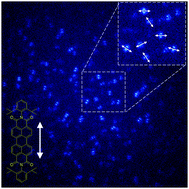Examining dynamics in a polymer matrix by single molecule fluorescence probes of different sizes†
Abstract
Rotational motion of single fluorescence probes with different sizes doped inside films of polyvinylacetate is investigated by defocused single molecule fluorescence microscopy. Discrete vibration modes in the rotational motion of individual probes are clearly exposed in the power spectra of the rotation trajectories, reflecting multiple relaxation dynamics and also the difference in dynamics among separate locations. The power spectra show a strong dependence on the probe size and temperature. By sampling the rotation of a large number of probes, the averaged power spectra show that the activated rotation of the probes falls into the frequency range of the α-relaxation and data analysis shows that activation of the vibration modes with all probes corresponds to the maximum population of rotating probes, and this made the comparison between single molecule data and the ensemble data meaningful (differential scanning calorimetry, as an example). Such an analysis shows a coincidence between the temperature of a significant occurrence of glass transition and the activation of rotational motion of all probes with one specific size, indicating that such a dimension correlates with the size of the cooperative rearrangement region – a volume of approximately 1.0 nm3.


 Please wait while we load your content...
Please wait while we load your content...